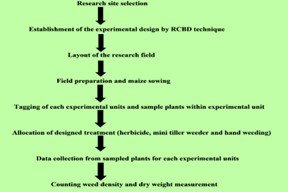Effect of different weed management practices on production of spring maize in Dang, Nepal
Abstract
The study was carried out at Lamahi-8, Satbariya, Dang to evaluate the effect of different weed management practices on the production of spring maize. The experiment was carried out in a Randomized Complete Block Design using three replications and seven treatments. Rampur hybrid 10 variety and early post emergence (EPoE) herbicide were used in the experiment. The treatment consisted of single as well as combined weed management methods as T1: Broadcasting-One hand weeding, T2: Broadcasting-Herbicide, T3: Line sown- One hand weeding, T4: Line sown-Herbicide + one hand weeding, T5: Line sown- Mini tiller weeder, T6: Line sown- herbicide + mini tiller and T7: Line sown- One hand weeding + mini tiller. The experiment result showed that the combined application of early post emergence herbicide and mini tiller resulted the highest grain yield (8.62 Mt/ha) with minimum total weed density at 60 DAS (41.33/m2) and at harvest (68/m2) thus resulting minimum weed dry weight at 60 DAS (5.45 g/m2) and at harvest (10.64 g/m2). Sixteen different weed species belonging to 9 different families were identified in the experimental field. The highest benefit: cost (3.37) was obtained in the treatment Line sown-Herbicide + mini tiller weeder which was significantly higher compared to other treatments. Among the treatments applied, one with the application of herbicide in combination with mini tiller weeder was found to be the most effective one that resulted in the minimum weed density and minimum dry weight, higher grain and biological yield with the highest benefit cost ratio thus proving to be the most economical one. At the same time, application of mini tiller weeder as a single method was found to be the next better alternative for weed control in spring maize that could benefit the farmers in comparison to other single weed management practices.
Keywords:
Benefit: cost, Broadcasting, Herbicide, Mini tillerDownloads
References
Bista, K., Gaire , R., & Devkota, K. (2021). Evaluation of open pollinated and hybrid maize varieties in the spring season at Baitadi district, Nepal. SAARC Journal of Agriculture , 19(2), 123-136.
Dahal, S., & Karki , T. B. (2014). Conservation agriculture based practices affect the weed dynamics in spring maize. World Journal of Agricultural Research, 2(6A), 25-33.
Dhakal, S., Sah, S. K., Amgain, L. P., & Dhakal, K. H. (2022). Maize Cultivation: Present status, major constraints and farmers perception at Madichaur, Rolpa. Journal of Agriculture and Forestry University, 5, 125-131.
Fang, H., Niu, M., Wang, X., & Zhang, Q. (2022). Effects of reduced chemical application by mechanical-chemical synergistic weeding on maize growth and yield in East China. Frontiers in Plant Science, 13.
Ghimire, Y. N., Timsina, K. P., Devkota , D., Gautam, S., Choudhary, D., Poudel, H., & Pant, J. (2018). Dynamics of Maize Consumption and its Implication in Maize Technology Demand in Nepal. CIMMYT.
Guragain, M. (2019). Maize worth 71 billion imported in 10 years. My Republica.
KC, G., Karki, T. B., Shrestha, J., & Achhami, B. B. (2015). Status and prospects of maize research in Nepal. Journal of Maize Research and Development, 1(1), 1-9.
Khanal , P., Karn, R., Chhetri, P. B., Karki, S., & Sah, S. K. (2019). Response of Maize Varieties To Sowing Dates In Inner Terai Region, Dang Nepal. Malyasian Journal of Halal Research Journal, 2(2), 27-31.
Marahatta , S. (2018). Weed science research and achievement in Nepal. The Journal of Agriculture and Environment, 19, 118-129.
MoALD. (2021). Statistical Information on Nepalese Agriculture 2020/21, Ministry of Agriculture and Livestock development, Government of Nepal. Kathmandu.
Ram, P., Sreenivas , G., & Rani, P. L. (2017). Impact of Sustainable Weed Management Practices on Growth, Phenology and Yield of Rabi Grain Maize
(Zea mays L.). International Journal of Current Microbiology and Applied Sciences, 6(7), 701-710.
Sharma, S., Marahattha, S., Sah, S. K., & Karki, T. B. (2018). Efficacy of different tillage and weed management practices on phenology and yield of winter maize (Zea mays L.) in Chitwan, Nepal. International Journal of Plant and Soil Sciences, 26(2), 1-11.
Shrestha , A., Thapa , B., & Kandel , S. (2019). Assessment of different weed management practices in yield and yield attributes in summer maize in inner Terai of Nepal. Journal of Research in Weed Science, 2(3), 224-229.
Shrestha , A., Thapa , B., Devkota, M., & Subedi, R. (2018). Comparative Efficiency of Different Weed Management Practices on Yield and Economic in Summer Maize in Dang. Advances in Crop Science and Technology, 6(2), 1-4.
Shrestha , J., Timsina, K. P., Subedi, S., Pokhrel, D., & Chaudhary, A. (2019). Sustainable Weed Management in Maize (Zea mays L.) Production : A Review in Perspective of Southern Asia. Turkish Journal of Weed Science, 22(1), 133-143.
Shrestha, J., Gurung, B. D., Koirala, K. B., & Rijal, T. R. (2019). Performance evaluation of maize in Jumla district of Nepal: from yielding perspective. International Journal of Applied Biology, 3(2), 35-45.
Shrivastav, N., Basnet, K. B., Amgain, L. P., Karki, T. B., & Khatri, N. (2015). Weed dynamics and productivity of spring maize under different tillage and weed management methods. Azarian Journal of Agriculture, 2(5), 118-122.
Singh, K., Kaur, T., Bhullar, M., & Brar, A. (2018). The Critical period for weed control in spring maize in North-West India. Maydica, 61(1), 2-7.
Thapa, R. (2021). A Detail Review On Status And Prospect Of Maize Production In Nepal. Food and Agri Economics Review, 1(1), 52-56.
Triveni, U., Rani, Y. S., Patro, T., & Bharathalakshmi, M. (2017). Effect of different pre- and post-emergence herbicides on weed control, productivity and economics of maize. Indian Journal of Weed Science, 49(3), 231-235.
Tursun , N., Datta, A., Sakinmaz, M. S., kantarci, Z., Knezevic, S. Z., & Chauhan, B. S. (2016). The critical period for weed control in three corn (Zea mays L.) types. Crop Protection, 90, 59-65.

Published
How to Cite
Issue
Section
Copyright (c) 2023 Agriculture and Environmental Science Academy

This work is licensed under a Creative Commons Attribution-NonCommercial 4.0 International License.

